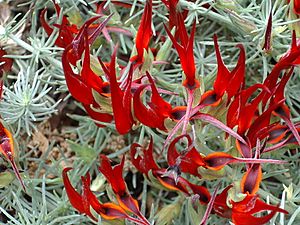Lotus berthelotii facts for kids
Quick facts for kids Lotus berthelotii |
|
|---|---|
 |
|
| Scientific classification | |
| Genus: |
Lotus
|
| Species: |
berthelotii
|
| Synonyms | |
|
|
Lotus berthelotii is a beautiful flowering plant. It is found only in the Canary Islands of Spain. This plant is part of the pea family, called Fabaceae. People often call it names like lotus vine flower or parrot beak. This is because its flowers look a bit like a bird's beak!
Sadly, this plant is very rare. It might even be extinct in the wild. This means it no longer grows naturally in its home. Only a few plants might still exist. Even in 1884, people knew it was "exceedingly rare." Collecting these plants probably made them disappear faster.
Contents
What Does the Parrot Beak Plant Look Like?
The Lotus berthelotii is an evergreen plant. This means it stays green all year round. It is a low-growing prostrate shrub or subshrub. It usually grows to about 20 centimeters (8 inches) tall. Its branches spread out or trail along the ground.
The leaves of this plant are special. They are divided into 3 to 5 thin leaflets. Each leaflet is about 1 to 2 centimeters long. They are very narrow, only about 1 millimeter wide. These leaves are covered with fine, silvery hairs. This gives the plant a lovely silvery look.
The flowers are bright orange-red to red. They are shaped like beaks pointing upwards. Each flower is about 2 to 4 centimeters long. They are slender, about 5 to 8 millimeters wide. These unique flowers grow on short stalks.
How Does the Parrot Beak Plant Get Pollinated?
The flowers of Lotus berthelotii seem perfect for bird pollination. This means birds help them make seeds. Some other plants from the Canary Islands also use birds for pollination.
For a long time, people thought that special sunbirds used to pollinate these plants. They believed these sunbirds had died out in the Canary Islands. This would explain why the plants became so rare.
However, newer studies show something different. Regular birds that visit flowers can pollinate these plants. The Canary Islands chiffchaff is one such bird. These plants even have special ways to deal with birds that don't visit very often. For example, their flowers stay open longer. This gives birds more time to find them.
Scientists also studied some cultivated Lotus berthelotii plants. These plants did not produce any fruit. This happened even though they got a lot of pollen. This might be because all the plants came from one single plant. If a plant is "self-incompatible," it cannot make seeds with its own pollen. It needs pollen from a different plant. If all cultivated plants are the same, they can't make seeds. This is a big problem for saving this rare species.
Growing the Parrot Beak Plant
People love to grow Lotus berthelotii in their gardens. It is a popular ornamental plant. Its needle-like silvery leaves and red flowers make it very attractive. It is great for traditional gardens. It also grows well in pots.
This plant is also good for drought tolerant gardens. These gardens save water. The plant has even won an award called the Royal Horticultural Society's Award of Garden Merit. There is also a golden-orange flowering type that people grow.
The Lotus berthelotii does not like cold weather. It cannot handle freezing temperatures. So, in places with cold winters, it needs to be kept indoors. A greenhouse or a warm room is best. It also needs a sunny spot that is protected from strong winds.
See also
 In Spanish: Pico de paloma para niños
In Spanish: Pico de paloma para niños


